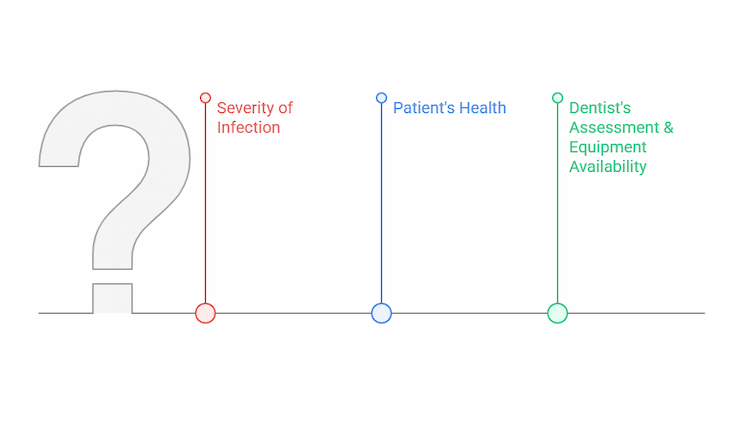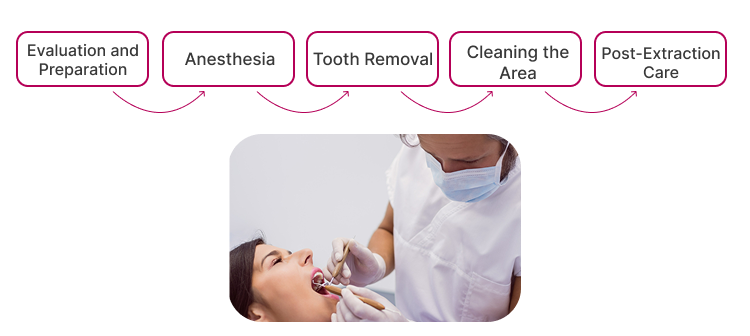Tooth pain can stop you in your tracks, especially when it’s caused by an infection. If you’ve ever wondered whether Same-Day Extraction for Infected Teeth is possible, you’re not alone. Many patients facing sudden swelling, throbbing pain, or fever want quick answers and fast relief.
While some infected teeth can be safely removed right away, others may require additional steps before tooth extraction. Understanding the signs of infection, what factors dentists consider, and how the procedure works can help you feel more prepared if you ever face this situation. That’s why in this article, we’ll walk you through everything you need to know about same-day tooth extractions.
What Is an Infected Tooth Extraction?

Sometimes a tooth that has developed a serious infection should be removed to stop the infection from spreading and to relieve pain. A tooth becomes infected when bacteria enter through a deep cavity, crack, or gum disease and reach the pulp. Once this happens, the infection can cause severe toothache, swelling, and in some cases, even spread to nearby tissues or other parts of the body.
But why is extraction needed? Dentists usually try to save an infected tooth with treatments like root canal therapy or antibiotics; however, extraction may sometimes be the safest and most effective option.
Experts state that removing the infected tooth can prevent further complications, protect your overall health, and set the stage for future solutions like dental implants, bridges, or dentures.
Read more: Root canal therapy is the first choice when a tooth is infected but can still be saved. If you want to know the signs you might need an emergency root canal, check out our article.
Signs and Symptoms Indicating an Infected Tooth
Understanding the signs of a tooth infection early is important because untreated infections can spread and cause more serious health problems. Some of the most common symptoms include:
- Severe, persistent toothache: Pain that doesn’t go away, often described as throbbing or radiating to the jaw, ear, or neck.
- Swelling: The face, gums, or jaw near the tooth may appear swollen or tender to the touch.
- Sensitivity to hot and cold: Discomfort when drinking hot coffee or eating ice cream can be a clue.
- Fever: A systemic response that signals your body is fighting off infection.
- Bad breath or foul taste: Pus from the infection can create an unpleasant odor or taste in the mouth.
- Difficulty opening the mouth or swallowing: In severe cases, swelling can spread to surrounding tissues, making it hard to chew, swallow, or even breathe normally.
Note: Not every infected tooth will cause obvious pain right away. Sometimes the infection is silent, and that’s why regular dental checkups play such an important role in catching problems before they become emergencies.
Dealing With The Discomfort of An Infected Tooth?
At Pape Dental Centre, we understand how urgent tooth pain can be, and we’re here to provide safe same-day extractions when possible.
Schedule your appointment today to achieve fast relief and a healthy smile.
Factors That Influence Same-Day Tooth Extraction
If needed, your dentist might remove the infected tooth during your first visit, instead of scheduling it for later. Whether or not an infected tooth can be extracted on the same day depends on several factors. Dentists carefully weigh these considerations to make sure the procedure is safe and effective.

Severity of Infection
The extent of the infection is one of the most important factors. If the infection is localized and it’s contained within the tooth and surrounding gum, same-day extraction is usually possible.
However, if the infection has spread into the jawbone or surrounding soft tissues, a dentist may first recommend antibiotics to bring the infection under control before extraction.
Trying to remove a tooth in the presence of uncontrolled infection can increase complications and make anesthesia less effective.
Patient’s Overall Health
People with certain conditions, such as uncontrolled diabetes, immune system disorders, or heart problems, may need special precautions before undergoing any dental surgery. Medications, such as blood thinners, can also affect the timing and safety of the procedure.
In these cases, dentists often coordinate with a patient’s physician to decide the safest approach.
Dentist’s Assessment and Equipment Availability
The dentist’s clinical judgment and the resources available in the dental office determine if same-day extraction is the best option.
For example, advanced imaging tools or the availability of sedation can influence whether the tooth can be removed immediately. If the case is complex, the dentist might refer the patient to an oral surgeon for specialized care.
Read more: Did you know that regular dental cleaning can prevent tooth loss? If you want to know the risks of skipping dental cleanings, read the blog.
The Extraction Procedure for an Infected Tooth
If your dentist decides that same-day extraction is the best option, the procedure usually follows a clear and safe process.

Evaluation and Preparation
Before starting, the dentist reviews your medical history, takes X-rays to assess the tooth and surrounding bone, and explains the steps. In some cases, antibiotics may be given beforehand to reduce the risk of spreading infection.
Anesthesia
Local anesthesia is used to numb the area. If the infection is severe and swelling makes numbing less effective, additional techniques or sedation may be considered.
Tooth Removal
Depending on the tooth’s condition, the dentist will either perform a simple extraction or a surgical extraction. Surgical extractions are more common for infected teeth, especially if the infection has damaged surrounding structures. According to the Cleveland Clinic, surgeons usually perform treatments in a clinical setting, but they might do it in a hospital if general anesthesia is needed.
Cleaning the Area
After the tooth is removed, the dentist thoroughly cleans the socket to remove any remaining infected tissue or debris. This helps promote proper healing and lowers the risk of complications.
Post-Extraction Care
Gauze is placed to control bleeding, and patients receive detailed aftercare instructions. This usually includes rest, avoiding smoking or alcohol, taking prescribed medications, and sticking to soft foods for the first few days.
Read more: Having a good dental hygiene routine minimizes infection and other complications. Find out what the 6 oral hygiene tools you need for daily oral care are and why they’re important.
Move Forward with Same-Day Extraction for Infected Teeth
If you’re experiencing symptoms such as persistent toothache, swelling, or fever, don’t delay seeking dental care. In many cases, infected tooth extraction can be performed on the same day, providing fast relief and preventing the infection from spreading further. The possibility of same-day extraction depends on factors like the level of the infection, your overall health, and your dentist’s professional judgment.
Here at Pape Dental Centre, we do more than just extractions. From treating bruxism to providing dental fillings and bonding, our Dental Clinic Danforth is here to give you the proper care for your smile’s unique needs.
FAQ
-
Will a dentist pull an infected tooth the same day?
If the infection is localized and the patient is healthy enough, dentists often perform a same-day extraction.
-
Can a dentist pull out a tooth if it’s infected?
Yes. General dentists are trained and qualified to extract infected teeth. However, if the infection is severe, the tooth is difficult to access, or there are complications like swelling that affect the airway, a referral to an oral surgeon may be recommended.
-
How long does it take to recover from an infected tooth extraction?
Initial healing takes about 1 to 2 weeks; however, most people feel significantly better within a few days. Complete healing of the bone and gum can take several weeks to a few months, depending on the patient’s health and the complexity of the extraction.
-
Will pulling an infected tooth stop the pain?
Of course. Once the infected tooth is removed and the area begins to heal, the source of pain is eliminated. Some mild soreness is normal after the procedure, but this usually improves quickly with proper care.
Have you ever faced a tooth infection or had an extraction? Share your experiences or questions in the comments below.


